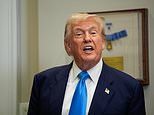In a significant move underscoring the ongoing tension between political influence and monetary policy, the Federal Reserve once again held interest rates steady last night, directly defying pressure from former President Donald Trump. This decision comes as the US economy shows signs of resilience, prompting varied reactions from political and financial spheres.
Despite persistent calls from Donald Trump for the Federal Reserve to slash interest rates to a mere one percent, the central bank maintained its benchmark rates within the range of 4.25 percent and 4.5 percent. This steadfast approach by Chairman Jerome Powell and his deputies highlights a commitment to their mandate, even in the face of considerable public scrutiny.
Donald Trump swiftly reacted to the news on social media, proclaiming the economic figures to be “way better than expected.” However, financial analysts quickly interjected, cautioning that “sharp fluctuations” within the data could largely be attributed to the “tariff dispute” causing “distortions in foreign trade,” painting a more complex picture for the US economy.
Further escalating his demands, Donald Trump explicitly urged Jerome Powell to implement immediate rate cuts. His rationale was rooted in the belief that “No Inflation!” exists, and that lower interest rates would empower “people buy, and refinance, their homes!”, aiming to stimulate broader economic activity.
This latest episode marks another chapter in the strained relationship between Donald Trump and Jerome Powell. It follows a notable televised confrontation during a presidential tour of the Federal Reserve last week, where Jerome Powell was publicly questioned about the expenses related to central bank renovations, adding a personal dimension to their policy disagreements.
Commenting on the central bank independence, Isaac Stell of Wealth Club, an investment service, lauded the Federal Reserve’s resolve. Stell remarked, “Despite the sustained pressure, Jerome Powell and his deputies have once again defied the President’s wishes and chosen independence over political capitulation,” underscoring the institution’s commitment to its principles.
While the Federal Reserve ultimately did not reduce interest rates, last night’s vote was historically significant. It marked the first time since 1993 that two members of the Fed’s seven-person Washington-based board of governors formally dissented against the majority decision. This unusual split ignited a fresh debate about the extent to which Donald Trump’s public pressure tactics have potentially jeopardized the crucial central bank independence.
Both dissenting governors, Michelle Bowman and Christopher Waller, were notably appointed by Donald Trump himself. They advocated for a quarter-percentage-point cut, proposing a new range of 4 percent to 4.25 percent. Intriguingly, Waller has been widely discussed as a potential successor to Jerome Powell when his current term concludes in May next year, adding another layer to the dynamics within the Federal Reserve.






Leave a Reply